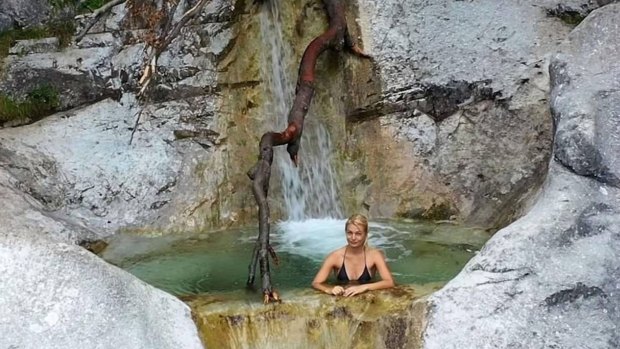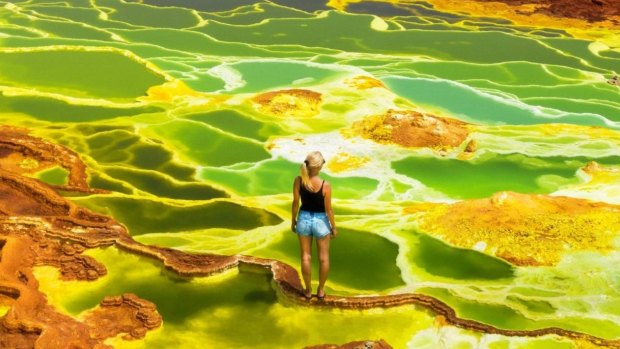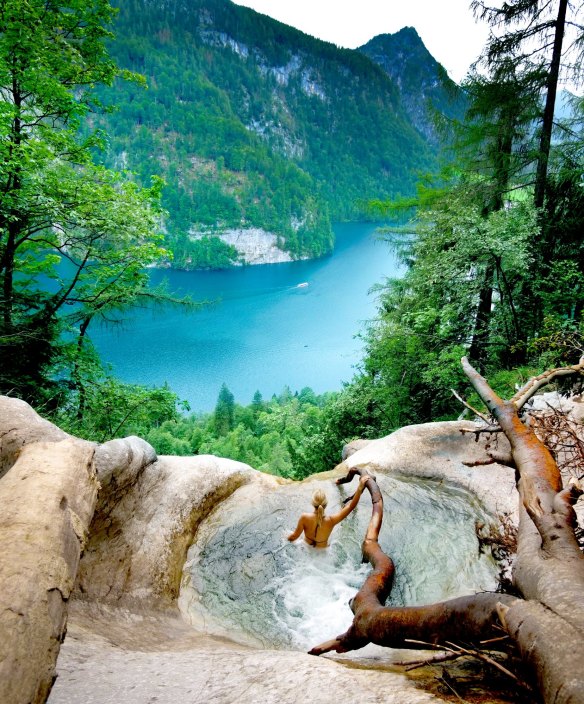This was published 4 years ago
Berchtesgaden National Park waterfall pool: Kiwi bloggers discover spectacular hidden swimming spot
By Lorna Thornber
When you've driven through war-torn South Sudan and across the vast salt desert of Ethiopia's Danakil Depression in Ethiopia, often described as one of the hottest, driest and most inhospitable place on Earth, climbing into a small pool above a 200 metre waterfall in a Bavarian forest doesn't seem all that daunting.
So says Bridget Thackwray, who, together with boyfriend Topher Richwhite, is more than 500 days into a three-year, round-the-world mission to highlight humans' impact on the planet through photographs and video footage, seeking out some of the world's least visited spots in the process.
Arriving in Berchtesgaden, an alpine region close to the Germany-Austria border in which local legend has it angels, startled by God's sudden appearance, dropped the vast majority of Earth's wonders by accident, the Kiwi couple did as they typically do when arriving in a new place and asked a local what there is to do in the area.

The Kiwi couple followed a local's directions to the 'hidden pool'.Credit: Expedition Earth
The woman told them about the "hidden pool" deep within the UNESCO-listed biosphere reserve of Berchtesgaden National Park, fed by one of Germany's highest waterfalls.
Following the woman's directions, the couple set off down the trail that circumnavigates mountain-ringed Lake Konigssee before veering off piste.
"She told us how to find it, but once we began it was much more difficult to find than she had described," 25-year-old Bridget, from Kerikeri, says. "I think we went a little off the typical route the locals use to get there, as it was only on the way back we found the small wild-track she had mentioned."

Bridget in the "alien-like" landscape of the Danakil in Ethiopia.Credit: Expedition Earth
Fortunately, Konigssee waterfall has a loud roar and they followed it until they came up against a surging wall of water.
"Once you reach the waterfall, the most difficult thing is working out if the pool is up or down, as you find yourself in the middle of the bush with the water rushing past," Bridget says. "Once we realised it was above the waterfall, we were a little more concerned."

Credit: Expedition Earth
They hadn't heard that a tourist had to be rescued by helicopter after falling part way down the waterfall earlier this year. If they had, she says "it would have made the whole experience a lot harder" and possibly dissuaded them visiting. As it was, they pressed onwards and upwards along the tree line.
Seemingly a natural-born adventurer, Bridget had no qualms getting into the "freezing" pool in a bikini so Topher, 33, could take pictures and drone footage.
"From inside the pool you cannot see the waterfall's drop, so you feel misleadingly safe... The water is freezing, as it comes straight from the mountains. Saying this, with adrenaline pumping it's hard to even notice the temperature."
While the large ledge between her body and the drop gave her the impression that you "would need probably be pushing the limits a little" to fall, she did feel a bit uneasy when she took her feet off the bottom.
"[I]f you take your feet off the bottom of the pool the water's current gives a large upwards push. That wasn't a great feeling!"
Asked whether she and Topher have always been daring, Bridget says the fact they decided to drive around the world together on their second date and actually did three months later "shows we have always been spontaneous and loved living life with a little risk.
"Many of our friends still say they would never want to do what we are doing, especially when it has involved driving through countries such as Nicaragua and Sudan in a civil war. Getting into a swimming pool above a beautiful waterfall actually seems pretty safe to us now compared to what could have happened in some of the regions we have driven through en route. But yes, the more experiences we have like this, the more immune and less afraid we become. It has probably been a change we have not noticed in ourselves."
That said, the couple take precautions before venturing somewhere risky. Before heading to Konigssee, for example, they checked the weather forecast, conscious that water levels could rise in a downpour, and searched upstream for objects such as loose logs which could fall down on them.
While some of those who commented on their images of the waterfall on social accused them of letting out a local secret, Bridget says their travels have taught them that tourism can be an area's saving grace.
"By driving the planet we see the "in-between" areas, which most don't when they fly to destinations. These in-between areas are typically the most polluted or environmentally impacted. When there is no revenue from tourism, there is little need to keep the area beautiful. Locals create a living from different means, which can often be in the areas of deforestation or poaching. When a new area trends, this indirectly can "save" an environment and result in locals and government investing in the area to keep it pristine and beautiful."
Bridget says their world voyage, which they have dubbed Expedition Earth, has taught them that overpopulation is among the biggest threats to the planet - so-called overtourism, she says, is a mere byproduct.
"The largest realisation we have had from Expedition Earth is that mankind really have completely overtaken this planet. There is almost no space to allow any other species to exist, and almost no space for us to keep expanding into."
As they travel through India and China next year on their way back to New Zealand, Bridget says she will be surprised if they encounter any truly wild areas at all beyond those "protected solely because of the tourism demand to see wildlife".
They are excited about the roads ahead, however, which they'll drive in their trusty Jeep Wrangler "Gunther" eastward to Russia before heading down to Asia. They're particularly looking forward to an area along the Kyrgyzstan-China border which has only recently been reopened to visitors. Working with National Geographic has enabled them to access areas off-limits to most tourists, Bridget says, which often prove to be their favourite places.
As hard as it has been to stick to their mission to explore "landscapes untouched by humans" in Europe, Bridget says they've had some pleasant surprises, Konigssee included.
"The underground cities in Turkey were also amazing. With the balloons getting all of the attention, they are less explored."
The trick, it seems, is to dare to be different and go in the opposite direction to the crowds.
You can follow Bridget and Topher's journey on Instagram.
Sign up for the Traveller Deals newsletter
Get exclusive travel deals delivered straight to your inbox. Sign up now.